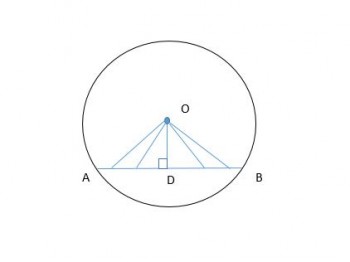nailgmat2015 wrote:
Asifpirlo wrote:
On the coordinate plane , points P and Q are defined by the coordinates (-1,0) and (3,3), respectively, and are connected to form a chord of a circle which also lies on the plane. If the area of the circle is (25/4) π , what are the coordinates of the center of the circle ?
(A) (1.5,1)
(B) (2,-5)
(C) (0,0)
(D) (1,1.5)
(E) (2,2)
Although it took me 3 mins to solve this question using all those equations, later I thought this question can be solved easily using options.
One property to keep in mind - A line passing through the centre of the circle bisects the chord (or passes from the mid point of the chord).
Now mid point of chord here is (-1+3)/2, (3+0)/2 i.e. (1,1.5) now luckily we have this in our Ans. choice. so definitely this is the ans. It also indictaes that PQ is the diameter of the circle.
There can be a case when PQ is not a diameter but in that case also the y-coordinate will remain same as it is the midpoint of the chord and we are moving up in the st. line to locate the centre of the circle.
If ans choices are all distinct (y cordinates) ONLY CHECK FOR Y CORDINATE and mark the ans.
Hi
nailgmat2015,
Please note that
every line passing through centre of the circle does not bisect the chord. Only the line which passes through the centre and is perpendicular to the chord bisects the chord. For example refer the diagram below. In this diagram there are various lines which pass through the centre and intersect the chord, but only OD will bisect the chord as it is perpendicular to the chord.

For this question, you got the right answer as you assumed PQ to be the diameter which is actually the case. A better method for this question would have been:
Step-IFind the radius of the circle from the given area of the circle which gives us radius = 2.5 and hence diameter = 5
Step-IIIn this case, we can observe that the length of the chord PQ is 5( by using the distance formula). Since the length of chord PQ is equal to the length of the diameter that would mean that PQ is the diameter of the circle.
Since PQ is the diameter of the circle, the midpoint of PQ would be the centre of the circle which gives us the coordinates of centre as (1, 1.5)
Hope its clear

Regards
Harsh



 45%
(medium)
45%
(medium)
 29%
(02:49)
wrong
29%
(02:49)
wrong  based on 210
sessions
based on 210
sessions






